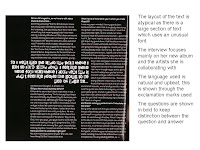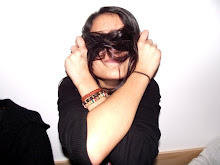














 The image above is a copy of an annotated version on NME's reader profile. This task was created to provide us with an understanding on what information to include on our own reader profiles for our magazines. This reader profile included what the content of the magazine includes and how they target their audience effectively. I used this reader profile to help me create my own reader profile for my magazine. It also showed me what would be most effective in my magazine and how it would target my audience.
The image above is a copy of an annotated version on NME's reader profile. This task was created to provide us with an understanding on what information to include on our own reader profiles for our magazines. This reader profile included what the content of the magazine includes and how they target their audience effectively. I used this reader profile to help me create my own reader profile for my magazine. It also showed me what would be most effective in my magazine and how it would target my audience. This image was taken from a simulation task in which we were asked to position ourselves for a photo which would be related to the genre in which we were given. My partner Kanwal and I were given the genre of pop, using this we had a few minutes to come up with a pose which would represent that particular genre. We decided to make ours casual and happy as those are the connotations of pop music. The leg being close to the body gives a sense of comfort and innocence which we feel represents pop music very well. The facial expression is happy which relates to the genre and pop music is connoted to be happy and fun.
This image was taken from a simulation task in which we were asked to position ourselves for a photo which would be related to the genre in which we were given. My partner Kanwal and I were given the genre of pop, using this we had a few minutes to come up with a pose which would represent that particular genre. We decided to make ours casual and happy as those are the connotations of pop music. The leg being close to the body gives a sense of comfort and innocence which we feel represents pop music very well. The facial expression is happy which relates to the genre and pop music is connoted to be happy and fun.
 My interview above is based around questions created around the genre of pop rock. I chose questions which were related to my artist and that were appropriate to my target audience. The questions were personal and based around her life, career and difficulties. The reason for me to use these forms of questions was so that the readers can understand and develop a bond with her. It could also provide them with comfort if they are experiencing any problems in their lives as she may have experienced the same problems. The language used is casual and fun which attracts readers, also the style in which she talks is to the reader rather than the interviewer which allows them to imagine that they are with her.
My interview above is based around questions created around the genre of pop rock. I chose questions which were related to my artist and that were appropriate to my target audience. The questions were personal and based around her life, career and difficulties. The reason for me to use these forms of questions was so that the readers can understand and develop a bond with her. It could also provide them with comfort if they are experiencing any problems in their lives as she may have experienced the same problems. The language used is casual and fun which attracts readers, also the style in which she talks is to the reader rather than the interviewer which allows them to imagine that they are with her.

 The three pictures above were taken to get a basic image of what the picture in my interview would look like. I chose to position my models as if they don't realise the pictures being taken, this makes the image seem natural which is what I am trying to portray. I used a guitar in my images to show my audience the genre of music in which I am basing my magazine on and the talent needed to be successful in that genre. The lack of eye-contact shows a sense of innocence and commitment for their music; this represents the artists in my music genre as although they are loud and fierce, they have a sense of innocence about them.
The three pictures above were taken to get a basic image of what the picture in my interview would look like. I chose to position my models as if they don't realise the pictures being taken, this makes the image seem natural which is what I am trying to portray. I used a guitar in my images to show my audience the genre of music in which I am basing my magazine on and the talent needed to be successful in that genre. The lack of eye-contact shows a sense of innocence and commitment for their music; this represents the artists in my music genre as although they are loud and fierce, they have a sense of innocence about them.

 These two slides show some basic information about RWD's reader profile. The website contained the reader profile information but the two slides above show evidence from the magazine supporting it. As the magazine is targeted at young people aged 15-24, it bases the style of the magazine around the genre and age range.
These two slides show some basic information about RWD's reader profile. The website contained the reader profile information but the two slides above show evidence from the magazine supporting it. As the magazine is targeted at young people aged 15-24, it bases the style of the magazine around the genre and age range.










